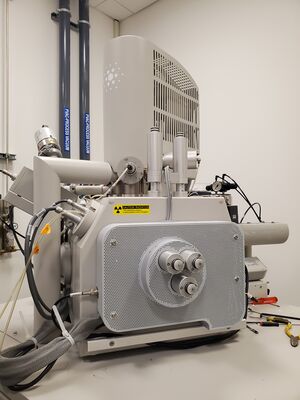Difference between revisions of "TFS Quanta 600 FEG ESEM"
| Line 13: | Line 13: | ||
| NEMO_Designation = TFS Quanta 600 ESEM | | NEMO_Designation = TFS Quanta 600 ESEM | ||
| Lab_Phone = XXXXX | | Lab_Phone = XXXXX | ||
| − | | SOP Link = [https://sites.google.com/seas.upenn.edu/ncf-em-reference/quanta Quanta Reference Guide ] | + | | SOP Link = [https://sites.google.com/seas.upenn.edu/ncf-em-reference/microscopes/quanta/operating-guide Quanta Reference Guide ] |
}} | }} | ||
Revision as of 14:28, 14 October 2024
 |
|
| Tool Name | Quanta |
|---|---|
| Instrument Type | ESEM |
| Staff Manager | Jamie Ford, Nicole Bohn |
| Lab Location | 004 |
| Tool Manufacturer | Thermo Fisher Scientific (Formerly FEI) |
| Tool Model | Quanta 600F |
| NEMO Designation | TFS Quanta 600 ESEM |
| Nearest Phone | XXXXX |
| SOP Link | Quanta Reference Guide |
Description
The Quanta 600 FEG Mark II Environmental Scanning Electron Microscope achieves 1.5 nm resolution in ESEM mode and can be operated under a range of gaseous environments from 6 x 10-4 Pa to ~1000 Pa. It is equipped with a special wet STEM detector that is ideal for the imaging of nanoparticles in biological systems. This system is our platform for in-situ electron microscopy development with heating and cooling stages allowing imaging from 20-1000°C, dual Kleindiek nano-manipulators with a micro-droplet injection system for electrical and mechanical measurements, and gas injection systems for platinum and gold e-beam deposition.
Accessories
The Quanta SEM is equipped with a unique array of accessories to enable the combination of high-resolution imaging and nanoscale manipulation allowing for powerful in-situ experiments involving controlled stimuli and correlated response. An EDAX Energy Dispersive x-ray spectrometer (EDS) allows for chemical characterization via spectra, element mapping, or phase mapping, and an electron backscatter diffraction detector (EBSD) is available for characterization of crystallographic structures.
In-Situ Applications
In-situ capabilities include: nanoscale manipulation of specimen or probe, access to the large sample volume by fluids, gases, electrical, optical and mechanical probes; detection of sample response to such probes, including the electron beam itself; and the temperature dependences of all these phenomena.
EDS with TEAM
TEAM by EDAX is installed on the companion computer for EDS data collection and analysis. A guide for this program is available on our reference website.